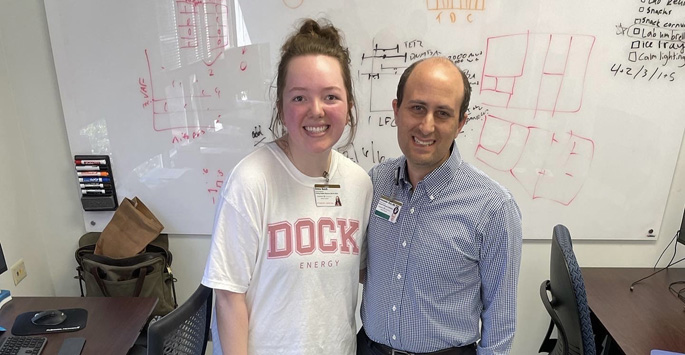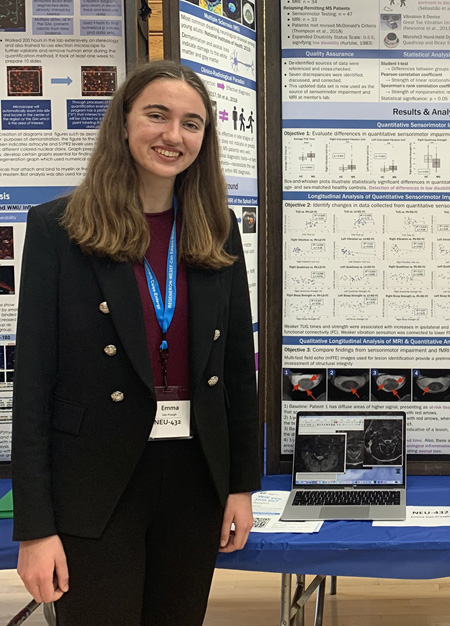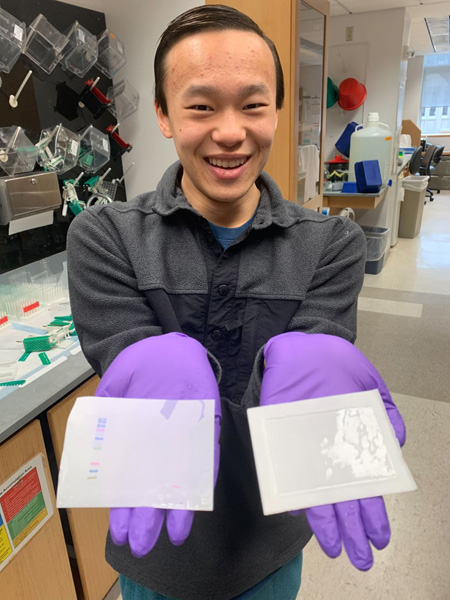
Three high school seniors with Vanderbilt mentors were selected for national honors by the Society for Science Regeneron Science Talent Search (STS).

The STS, which describes itself as one of “the nation’s oldest and most prestigious research competitions,” has alumni dating back to 1942. Many of those honored in previous years have gone on to distinguished careers in research, and some have achievements such as Nobel Prizes and Fields Medals.
This year, almost 2,000 applicants vied for a scholar position, with only the “Top 300,” including the three from Vanderbilt University Medical Center selected for their exceptional research.
They are:
- Emma Bunch, from Glasgow High School in Glasgow, Kentucky, who was mentored by Alex Bick, MD, PhD, assistant professor of Medicine in the Division of Genetic Medicine and director of the Vanderbilt Genomics and Therapeutics Clinic.
- Emma Van Praagh, from Pelham Memorial High School in Pelham, New York, who was mentored by Seth Smith, PhD, professor of Radiology and Radiological Sciences.
- Jason Wang, from Brentwood High School, in Brentwood, Tennessee, who was mentored by Ian Macara, PhD, chair of the Department of Cell and Developmental Biology and the Louise B. McGavock Professor. Wang moved to the next round in the competition and was chosen as one of the Top 40 finalists recognized at the awards ceremony on March 14.

Jason Wang of Brentwood, Tennessee, in the Macara lab with a gel transfer.
The students were given the opportunity to work on original research projects at Vanderbilt, diving straight into learning various laboratory techniques and how to formulate a scientific narrative under the guidance of faculty mentors, who brought not only their knowledge but their enthusiasm for science.
“This was something that I did in high school, I was also a ‘top 300,’ and it was a formative experience in my scientific journey,” Bick said. “Many of my faculty peers also had their first introduction to science research through these kinds of research experiences in high school, so it is very important to our future science pipeline.”
Each of the projects was scientifically challenging.
Bunch’s project was titled, “Clonal Hematopoiesis of Indeterminate Potential and Solid Tumors in Breast Cancer: An Analysis of Data in the NIH All of Us Research Program.” Her project involved computational biology and performing statistical analyses with the programming language, R.
Van Praagh’s project, “Investigating Connections Between Sensorimotor Impairment and Resting-State Functional MRI of the Spinal Cord in Multiple Sclerosis,” focused on understanding how the spinal cord functions at a resting state (functional MRI) and the relationship to sensory/motor performance of patients with multiple sclerosis.
Wang’s project, “Differential Effects of Oncogenic Ras Isoforms on Epithelia,” investigated the earliest changes that occur in a cell when a cancer gene is switched on in that cell. His work led to the discovery that cancer cell junctions lose their molecular glue, E-cadherin, which may enhance cancer cell movement, leading to metastasis.
But beyond the research that these high school seniors were doing in their spare time, the faculty mentors were deeply impressed by the work ethic and character of the students.
Bick recalled that when he first met Bunch, she summarized several of his research papers she had read and discussed them with him with insight that he described as “at the level I would expect from discussions with a first-year PhD student, not a 17-year-old high school student.” Bunch stated that she “found her people” in the Bick lab. “I loved talking to them about scientific topics I was passionate about and collaborating with them. Having that shared camaraderie meant the world to me.” She will be attending Harvard University, and said she is excited for what lies ahead.
Smith noted that Van Praagh was required to learn a huge amount of information to take on her research subject. “I was absolutely blown away by the focus she brought to the lab, and how she was able to distill large volumes of difficult information into the nugget of information that we needed to move the project forward,” he said. Van Praagh learned of Smith’s research through a mutual connection and noted that “from performing data analysis to understanding the day-to-day role of a researcher at Vanderbilt, this experience has guided my path forward as I aim to pursue a career in medical research.”
Macara was deeply impressed by Wang’s work ethic: “He would begin swim training at 6 a.m. for two hours, then go to school, then come into the lab and work until 9 or 10 at night and work all weekend.”
Wang said that his time in the Macara lab “has been nothing short of life-changing” and hopes that “my work and background story as an STS Finalist can inspire other young researchers to take that first step. The future of the world, and STEM, rests in the hands of my generation — I want them to believe that they too can use the power of science to change our world for the better.” Wang will be attending MIT in the fall to study biomedical engineering.
Applications for the next round of Regeneron STS Scholars will open on June 1.












